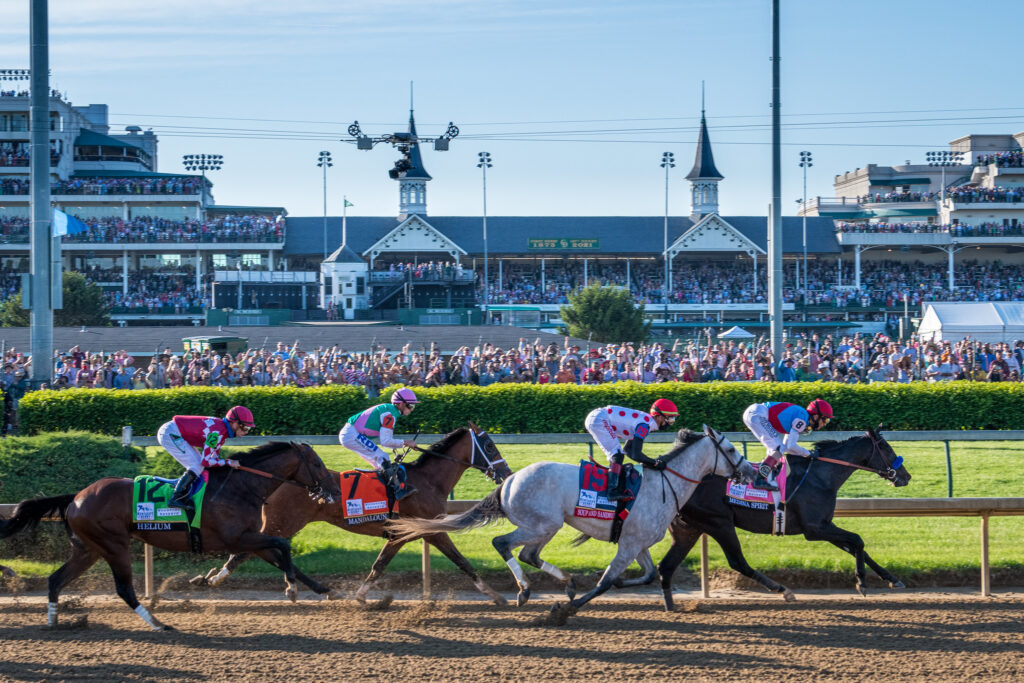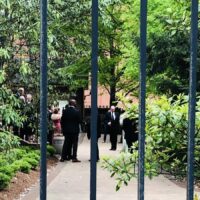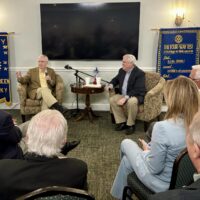A week before spring racing began at Churchill Downs, horses set to run in the Kentucky Oaks and Derby performed their high-speed exercises at the track.
A thin crowd of racing enthusiasts and tourists gathered in the front row seats near the finish line in the early morning hours, watching the horses trot alongside their track ponies, and eventually gallop around the freshly groomed track.
As the horses began their high-speed exercises, onlookers intently followed their progress. Suddenly, one tripped just as he crossed the finish line, drawing gasps from the more intent spectators. Luckily, the thoroughbred recovered quickly and continued his warmups without a pause.

One onlooker whispered under her breath, “That could have gone really bad.”
In horse racing, debilitating injuries can happen in seconds.
Last year, Churchill Downs was subject to investigations and heightened scrutiny after 12 young racehorses died within a month at the track, a few dying in those morning exercises before racing even began.
“None of us within our industry want to have to go through what we went through last spring,” said Dr. William Farmer, the Equine Medical Director for Churchill Downs.
Because of the deaths, Churchill Downs canceled its season midway through and moved to Ellis Park Racing & Gaming in Henderson, more than 100 miles away from the iconic twin spires of the Louisville racetrack.
After a year of testing and inquiries, federal, state and track investigations came up with no definitive pattern connecting the deaths.
“As a veterinarian, as a scientist, it is very frustrating because we like to find answers. We want to know why it happened,” Farmer said. “We also know that certain things happen in life that we don’t have answers for.”
The Horseracing Integrity and Safety Authority – a federal self-regulatory agency created under 2020 legislation – launched its own probe. CEO Lisa Lazarus said they came to the same conclusion, but were still able to glean useful information from the investigation.
- RELATED: Governor’s Derby guests?
“It’s not that we didn’t uncover the causes. It’s that there wasn’t one singular factor that caused each of the injuries, each of the fatalities,” Lazarus said.
After the deaths last year, Churchill Downs put a few safety measures in place and some remain in effect for this season. For example, horses who perform poorly for several races in a row can’t run and they’re also limited on the frequency.
But, at the same time, Churchill Downs has reinstated incentives that some believe encourage trainers to run horses that aren’t in tip-top shape. For example, a trainer whose horse doesn’t place in the top five will go back to still getting a small portion of the purse, which could theoretically encourage trainers to run their horse even if it has no chance of winning, or even a possibility of injury. Lazarus said there isn’t necessarily evidence that these track-based incentives lead to more injuries.
“There’s no proven increased risk in terms of statistical risk in terms of injury,” Lazarus said. “And so for that reason, we understand the decision.”
The Churchill Downs track surface has been analyzed repeatedly and new material added, and Lazarus said they’ve already been hearing positive feedback from jockeys. She also pointed to technology she said improves horse safety, like wearable tech to track the horse’s movement at high speeds and new track monitoring capabilities — although much of that technology was already in place last year.
Farmer noted that Churchill Downs is only the second U.S. racetrack to have a permanent PET machine on site, which he said improves diagnostic vet exams.
This will also be the first year that the federal agency’s anti-doping regime will be in place at Churchill Downs. Kentucky’s state agency had its own program, but the newer program will bring consistency across states and the industry as a whole.
“We feel really comfortable knowing that these horses have been tested repeatedly. If they’re running in the Derby, it means they have not had an issue with our program,” Lazarus said.
She said her organization is often a lot faster than state authorities to make decisions and cite infractions, including for doping. Lazarus said she hopes swifter repercussions will lead to less infractions in the long term as well.
Even in a typical season, racing is dangerous for horses. According to the Jockey Club, 336 horses died last year from racing-related injuries.
Racehorses are bred for speed not bulk, which often results in thin legs capable of running at incredibly high speeds. With those slighter limbs, even small breaks in some of a horse’s leg bones can be debilitating — for example, fractures in the small sesamoid bones in a horses’ fetlock (the hinge joint above a horse’s hoof, similar to an ankle) can cause ruptures in surrounding ligaments and tendons. Those fractures could potentially damage the structural integrity of a horse’s entire leg.
Unlike some quadrupeds, horses need to put equal weight on all four legs, making the healing process difficult.
“We have to look at the overall quality of life for a horse outside of the injury itself, because there are most things that we can likely heal,” Farmer said.
With some complex breaks, it’s unlikely a horse will be able to race again, and some might be unsuitable for any type of work besides hanging out in green pastures or being put out to stud. Farmer said there shouldn’t be a financial motive when an owner makes a racehorse’s medical decisions, and he said Churchill Downs has “partnered” with owners in the past to remove those barriers.
“We’ve always had the stance that we don’t want finances to be a limiting option,” Farmer said.
An entire, largely nonprofit, industry of thoroughbred aftercare has grown in recent decades to better answer the question: How does a racehorse retire?
In Georgetown, 150 retired thoroughbred racehorses roam in green pastures at Old Friends’ farm, with nothing to do besides eat and occasionally greet a tour group.
Old Friends cares for a mixture of career thoroughbreds, including past Kentucky Derby winners, like 30-year-old Silver Charm, the oldest still living. Alongside him are horses who have survived severe injuries themselves, including one whose leg is mostly metal at this point, said CEO John Nicholson.
“We are a vibrant and living museum of the sport and of the great athletes who have participated in the sport,” Nicholson said.
Nicholson said, over the course of his multi-decade career in the industry, he’s seen more owners planning for their horses’ old age because aftercare has become more of an expectation in the business.
“For the first part of their lives, pretty much everyday they do what people tell them to do,” Nicholson said. “What happens at Old Friends as soon as they arrive here, we do what they tell us to do — what they want, what they like.”
The field is set for the running of the 150th Kentucky Derby at Churchill Downs this Saturday.
This story is republished with permission from WKMS. Read the original.
Sylvia Goodman is Kentucky Public Radio's Capitol reporter. Email her at sgoodman@lpm.org.






